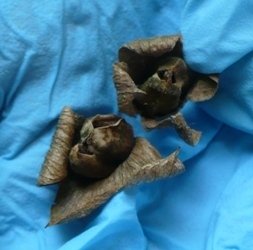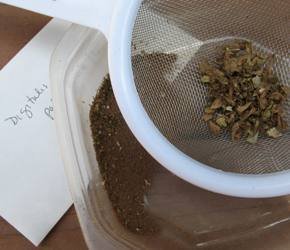





Common foxgloves have spectacular blooms and are fairly easy to grow. The flowers are finished all too soon, though. In early summer you may be looking at ugly dried spears of ripening pods. Instead of bidding "adieu" (farewell), say "au revoir " (till I see you again) to your Digitalis. Gather seeds, and guarantee a new crop of these lovelies next spring.
Many gardeners buy foxglove (Digitalis purpurea) plants, enjoy the fabulous flowers, and then discard the withering stems in summer. Foxgloves are biennial, so their decline at this point is to be expected. Luckily, growing foxgloves from seed is hardly any more difficult than planting those young plants. You'll stretch your gardening budget, too. The seeds are generously supplied by your own spent plants.
Foxglove's flowers bloom in succession from the bottom to the top of the tall stems. The pods turn dry and brown in similar fashion. They ripen first near the bottom of the stem. Watch the lower pods for cracks and holes. The "fox's gloves" change to resemble turtle's beaks, and split in the middle. The seeds mostly stay inside the upright pods. When a ripe pod is turned down, tiny brown or black seeds will spill out. They are small, like finely ground black pepper, as you see in the picture to the right. The seeds are easy to collect, share with fellow gardeners, or sow in other areas in your garden.
Close view of the beak-like dried pods of foxglove

To harvest a small amount of seed, take a pod and turn it downward over an open envelope. One pod can yield dozens of seeds. Label the envelope now before you have a chance to forget.
To gather larger amounts of seed, equip yourself with a larger collection device. A large pan, plastic bin, or disposable aluminum roasting pan gives a large collection area for the seeds. It also has corners in which to gather the seed for pouring into a storage container. Pick a dry sunny calm day, and wait until any dew has dried off. Glove up, then prune off the flower spike below the bottom bud and turn it upside-down over the pan.You may see dozens of seeds drop into the pan with no further encouragement. Or you may use one hand to gently crush the pods, from the cut end of the stalk to the tip. Seeds will fall into the pan, along with bits of pod and dry petals. Discard the stripped stem (and don't be surprised if foxgloves later sprout where it fell.). Now gently shake the pan to make the seed gather in one corner. The tiny seeds will fall to the bottom of the pile, and larger flakes of petal and pod can be brushed away. It may be wise to avoid getting the seed and chaff too  close to your face. A few minutes of work will yield a reasonably clean pile of seed. Even easier than this, a kitchen strainer works well to get the chaff out of the seeds. (Knowing what we know, or don't know, about foxglove toxicity, you may want to dedicate a strainer to garden seed use only.) Pour the seed into a labeled envelope or small plastic bag.
close to your face. A few minutes of work will yield a reasonably clean pile of seed. Even easier than this, a kitchen strainer works well to get the chaff out of the seeds. (Knowing what we know, or don't know, about foxglove toxicity, you may want to dedicate a strainer to garden seed use only.) Pour the seed into a labeled envelope or small plastic bag.
A sieve makes quick work of separating tiny seeds from larger bits of dried pods
Have you planned a new foxglove patch already? Amend the soil if necessary, and rake it smooth. Cut a foxglove stem, carry it carefully upright to your chosen new location, then invert the stem and crush the pods. Hundreds of seed will fall. Let nature take over the care, and chances are good you will have plenty of seedlings by late summer.
Copyright © www.100flowers.win Botanic Garden All Rights Reserved